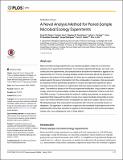A Novel Analysis Method for Paired-Sample Microbial Ecology Experiments
Author(s)
Techtmann, Stephen M.; Fortney, Julian L.; Bastidas-Oyanedel, Juan R.; Rodríguez, Jorge; Hazen, Terry C.; Alm, Eric J; Olesen, Scott Wilder; Vora, Suhani Deepak; ... Show more Show less
DownloadOlesen-2016-A Novel Analysis Met.pdf (544.6Kb)
PUBLISHER_CC
Publisher with Creative Commons License
Creative Commons Attribution
Terms of use
Metadata
Show full item recordAbstract
Many microbial ecology experiments use sequencing data to measure a community’s response to an experimental treatment. In a common experimental design, two units, one control and one experimental, are sampled before and after the treatment is applied to the experimental unit. The four resulting samples contain information about the dynamics of organisms that respond to the treatment, but there are no analytical methods designed to extract exactly this type of information from this configuration of samples. Here we present an analytical method specifically designed to visualize and generate hypotheses about microbial community dynamics in experiments that have paired samples and few or no replicates. The method is based on the Poisson lognormal distribution, long studied in macroecology, which we found accurately models the abundance distribution of taxa counts from 16S rRNA surveys. To demonstrate the method’s validity and potential, we analyzed an experiment that measured the effect of crude oil on ocean microbial communities in microcosm. Our method identified known oil degraders as well as two clades, Maricurvus and Rhodobacteraceae, that responded to amendment with oil but do not include known oil degraders. Our approach is sensitive to organisms that increased in abundance only in the experimental unit but less sensitive to organisms that increased in both control and experimental units, thus mitigating the role of “bottle effects”.
Date issued
2016-05Department
Massachusetts Institute of Technology. Department of Biological EngineeringJournal
PLoS ONE
Publisher
Public Library of Science
Citation
Olesen, Scott W., Suhani Vora, Stephen M. Techtmann, Julian L. Fortney, Juan R. Bastidas-Oyanedel, Jorge Rodríguez, Terry C. Hazen, and Eric J. Alm. “A Novel Analysis Method for Paired-Sample Microbial Ecology Experiments.” Edited by Jean-François Humbert. PLoS ONE 11, no. 5 (May 6, 2016): e0154804.
Version: Final published version
ISSN
1932-6203